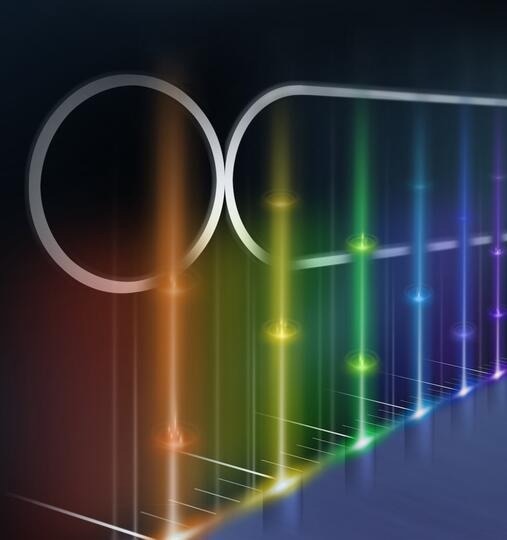On-chip laser frequency combs, which concurrently emit different light frequencies or colors and separate them like the teeth of a comb, are a revolutionary technique for a variety of uses in astronomy, metrology, optical computing, and the environment.

A new on-chip frequency comb combines a coupled resonator with an electro-optical frequency comb to improve the efficiency of frequency combs and improve the bandwidth. Image Credit: Yiqing Pei/Harvard SEAS
On-chip frequency combs still have severe limitations, though, in that they are not always effective. There are several solutions to the efficiency issue, but they all have trade-offs. For instance, combs can either have a wide bandwidth or a high efficiency, but not both.
For years, researchers have struggled to create an effective and wide-ranging on-chip laser frequency comb, which has prevented the widespread commercialization of these devices.
An electro-optic frequency comb that has been created by a team from Harvard’s John A. Paulson School of Engineering and Applied Sciences (SEAS) is now 100 times more effective and has a bandwidth that is more than twice as large.
Our device paves the way for practical optical frequency comb generators and opens the door for new applications. It also provides a platform to investigate new areas of optical physics.
Marko Lončar, Study Senior Author and Tiantsai Lin Professor, Electrical Engineering, Harvard’s John A. Paulson School of Engineering and Applied Sciences
The study has been released in the journal Nature Photonics.
This development builds on earlier work by Lončar and his group.
The first stable, on-chip, microwave-controllable frequency comb was demonstrated by Lončar and his team in 2019. Built on the lithium niobate platform invented by Lončar’s team, this so-called electro-optical frequency comb covered the whole telecommunications spectrum but had efficiency issues.
To control the flow of light, the researchers created coupled resonators in 2021. They subsequently used these coupled resonators to demonstrate on-chip frequency shifters, a device that can change the color of light with almost 100% efficiency.
The two ideas are used in the most recent research to address the efficiency-bandwidth trade-off problem in resonator-based electro-optic frequency combs.
We demonstrated that by combining these two approaches—the coupled resonator with the electro-optical frequency comb—we could improve the efficiency a lot without sacrificing bandwidth. In fact, we actually improved bandwidth.
Yaowen Hu, Study First Author and Research Assistant, Harvard’s John A. Paulson School of Engineering and Applied Sciences
Mengjie Yu, a former postdoctoral fellow at SEAS and study co-first author stated, “We found that when you improve the performance of the comb source to this level, the device starts operating in an entirely new regime that combines the process of electro-optic frequency comb generation with the more traditional approach of a Kerr frequency comb.”
At present, Yu is an Assistant Professor at the University of Southern California.
This brand-new comb can produce powerful, ultrafast femtosecond pulses. This device can be helpful for applications in astronomy, optical computing, range, and optical metrology in addition to being high-efficiency and broadband.
Co-authors of the study include Joseph M. Kahn, Di Zhu, Amirhassan Shams-Ansari, Linbo Shao, Rebecca Cheng, Brandon Buscaino, Neil Sinclair, and Mian Zhang.
It was funded in part by the Air Force Office of Scientific Research under grants FA9550-19-1-0376 and FA9550-19-1-0310, the Defense Advanced Research Projects Agency under grant LUMOS HR0011-20-C-137, NASA under grants 80NSSC21C0583, the Air Force Research Laboratory under grant FA9550-21-1-0056, the National Science Foundation under grant ECCS-1839197, and the Department of Energy under grant DE-SC0020376.
Journal Reference
Hu, Y., et al. (2022) High-efficiency and broadband on-chip electro-optic frequency comb generators. Nature Photonics. doi:10.1038/s41566-022-01059-y.